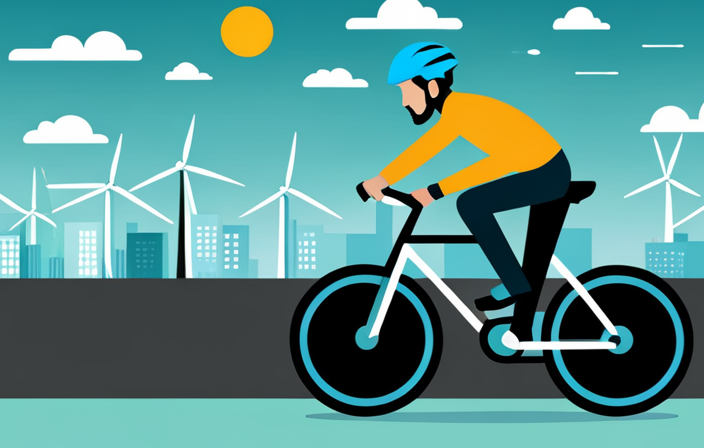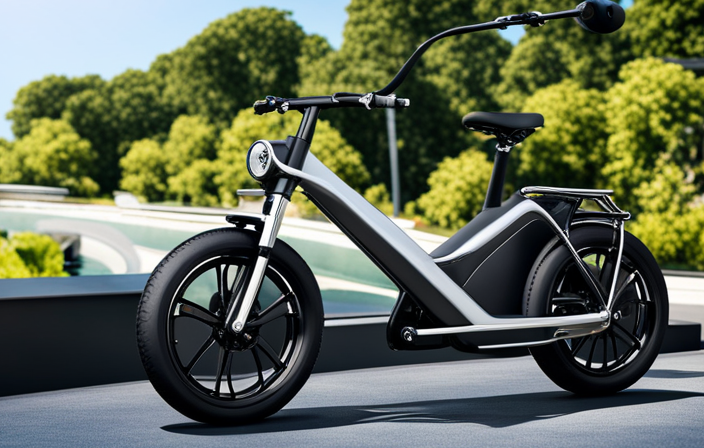I’ve always loved going on road trips, but recently, I discovered a new way to explore the open road: on an electric bike.
Did you know that electric bikes have an average range of 40-60 miles per charge? That’s pretty impressive, right?
But the big question is, where can you charge your bike along the way? In this article, I’ll share some valuable tips and resources for finding charging stations, planning overnight charging, and connecting with fellow electric bike enthusiasts.
Get ready to experience the freedom and flexibility of an electric bike road trip like never before!
Key Takeaways
- Planning is crucial for an electric bike road trip, including researching charging infrastructure and stations along the route.
- Portable solar panels can be a lightweight and eco-friendly option for charging on the go, reducing the carbon footprint.
- Connecting with local businesses and tourist attractions can provide convenient charging access and support local economies.
- Utilizing fast charging stations and planning for overnight charging at accommodations are essential strategies to ensure a fully charged battery.
Understanding Your Electric Bike’s Range
Understanding your electric bike’s range is crucial when planning a road trip. It’s important to know how far you can travel before needing to charge. Electric bike range estimation is influenced by several factors.
The first factor is the battery capacity. This determines how much energy your bike can store. A higher capacity battery will allow for a longer range.
The second factor is the terrain you will be riding on. Uphill sections and rough terrain require more power, which reduces your range.
Your riding style and speed can also affect the range. Riding at higher speeds or using the highest power assist level will drain the battery faster.
By considering these factors, you can estimate your electric bike’s range and plan your road trip accordingly.
Transitioning into researching charging infrastructure along your route, it is essential to ensure that you have access to charging stations to recharge your bike when needed.
Researching Charging Infrastructure Along Your Route
When planning your journey, make sure to research the availability of charging stations along your route. It’s crucial to know where you can recharge your electric bike to avoid running out of power in the middle of nowhere. Evaluating charging station availability and speed options will help you make informed decisions for a smooth road trip. Here’s a table to help you compare different charging stations:
| Charging Station | Location | Charging Speed |
|---|---|---|
| Station A | City A | Fast |
| Station B | City B | Medium |
| Station C | City C | Slow |
| Station D | City D | Fast |
Utilizing Public Charging Stations
To ensure a smooth journey, make sure to research the availability and speed options of public charging stations along your route. Researching charging etiquette and maximizing charging efficiency will help you make the most of these stations.
Here are some tips to help you enjoy your charging experience:
-
Plan your route: Before setting off, map out the locations of public charging stations along your route. This will ensure that you have a clear idea of where you can stop to recharge.
-
Check availability: Some charging stations may be more crowded than others. Research the availability of charging spots and consider making reservations if possible.
-
Consider charging speed: Different charging stations offer varying speeds. Look for fast chargers that can replenish your battery quickly, especially if you’re on a tight schedule.
By following these guidelines, you can make the most of public charging stations and keep your electric bike powered up throughout your journey.
As you continue your search for charging options, consider exploring campgrounds and RV parks, which often provide charging facilities for electric bikes.
Finding Charging Options at Campgrounds and RV Parks
Researching different campgrounds and RV parks is essential to finding charging options for your electric bike. While public charging stations are convenient, they may not always be available or accessible during your road trip.
This is where campgrounds and RV parks can come in handy. Many of these locations are now offering charging options for electric bikes and other electric vehicles. When planning your trip, be sure to check if your chosen campgrounds or RV parks have charging stations available.
This way, you can avoid any unexpected charging challenges and ensure that you have a reliable source of power for your electric bike. Once you have identified these locations, you can also start exploring charging networks and apps to further enhance your charging options.
Exploring Charging Networks and Apps
Once you’ve found campgrounds and RV parks with charging stations, you can now broaden your options by exploring different charging networks and apps.
When embarking on an electric bike road trip abroad, it’s important to research the charging options available in your destination. Different countries may have varying charging networks, so it’s crucial to familiarize yourself with the local providers and their coverage.
Additionally, comparing charging speeds at different stations will help you plan your route efficiently. Some charging networks may offer fast charging stations, while others may have slower options. By considering the charging speeds, you can estimate how long you’ll need to stay at each station to fully recharge. This knowledge will enable you to optimize your travel time and ensure a smooth journey.
Planning stops at hotels and accommodations with charging stations provides a convenient way to recharge your electric bike while enjoying a comfortable stay.
Planning Stops at Hotels and Accommodations with Charging Stations
After exploring the various charging networks and apps available for electric bike road trips, it’s time to plan our stops at hotels and accommodations with charging stations.
These establishments cater to the needs of electric vehicle users, offering convenient and reliable charging options for our bikes. Staying at hotels with charging options provides several benefits.
Firstly, it eliminates the worry of finding a charging point in a new location, ensuring we have a full battery each day. Additionally, these accommodations often have dedicated parking spaces for electric vehicles, providing added security and peace of mind.
Not only do we get to recharge our bikes overnight, but we also get to recharge ourselves in comfortable and well-equipped accommodations.
Now that we have our charging stops planned, let’s consider portable charging solutions for those times when we need a quick boost on the road.
Considering Portable Charging Solutions
When you’re planning your stops at hotels and accommodations with charging stations, it’s important to consider portable charging solutions for those times when you need a quick boost on the go.
Portable charging options come in handy when you don’t have access to a charging station or need to charge your electric bike while exploring remote areas. One key factor to consider when choosing a portable charger is battery capacity. Make sure to select a charger with sufficient capacity to fully charge your electric bike’s battery. It’s also advisable to opt for a lightweight and compact charger that won’t take up much space during your travels.
Considering these portable charging options will ensure that you have a reliable backup plan in case you can’t find a charging station nearby.
Now, let’s delve into using solar power for charging on the go.
Using Solar Power for Charging on the Go
Using solar power is a convenient and eco-friendly way to keep your devices charged while on the go. Portable solar panels offer numerous benefits for charging on the road.
Firstly, they are lightweight and compact, making them easy to carry in your backpack or attach to your bike. Secondly, they harness the power of the sun, which is a renewable energy source, reducing your carbon footprint. Additionally, solar powered charging allows you to stay connected even in remote locations where electricity may not be readily available.
With the advancements in technology, portable solar panels have become more efficient and can charge your devices quickly.
Transitioning into the next section, another option for charging on the go is to ask local businesses and restaurants for charging access.
Asking Local Businesses and Restaurants for Charging Access
After exploring the possibilities of using solar power for charging on the go, I discovered another valuable resource for keeping my electric bike powered up during my road trip: local businesses and restaurants.
Many establishments are willing to partner with electric bike riders to provide charging access, recognizing the growing popularity and environmental benefits of this mode of transportation. By reaching out to these businesses and establishing partnerships, I not only gained access to convenient charging stations but also supported local economies and built connections with the community.
Additionally, I found that some businesses offered alternative charging options, such as pedal-powered chargers or renewable energy sources. These innovative solutions not only helped me keep my electric bike charged but also highlighted the creativity and commitment of local businesses to sustainable practices.
Now, let’s explore how we can take advantage of charging opportunities at tourist attractions.
Taking Advantage of Charging Opportunities at Tourist Attractions
To make the most of your visit to tourist attractions, don’t forget to explore the charging opportunities available to keep your electric bike powered up. Many popular tourist spots now offer charging stations, so you can conveniently recharge while enjoying the sights.
Here are some tips to help you navigate the tourist attractions charging etiquette and maximize your charging time efficiency:
- Look for designated charging areas or stations at the attractions.
- Follow any guidelines or instructions provided for charging your electric bike.
- Be mindful of others who may also need to use the charging stations.
By taking advantage of these charging opportunities, you can ensure that your electric bike remains fully charged throughout your visit.
However, for quick boosts and when time is of the essence, utilizing fast charging stations can be a game-changer. These stations provide a rapid charge, allowing you to get back on the road quickly and continue your electric bike road trip without unnecessary delays.
Utilizing Fast Charging Stations for Quick Boosts
When you’re in a hurry and need a quick boost, fast charging stations can be a game-changer, allowing you to get back on the road quickly. The benefits of fast charging are undeniable. These stations are equipped with high-power chargers that can significantly reduce the charging time compared to regular charging stations. This means you can spend less time waiting and more time enjoying your electric bike road trip.
To make the most out of fast charging, there are a few best practices to keep in mind. First, always check the compatibility of your electric bike with the charging station to ensure a seamless charging experience. Second, plan your routes and identify fast charging stations along the way to avoid any unforeseen charging delays. Lastly, be mindful of the charging etiquette and try not to occupy the charging station for longer than necessary.
By following these best practices, you can maximize the benefits of fast charging and make your road trip even more efficient.
Speaking of charging, let’s now move on to planning for overnight charging at your accommodations.
Planning for Overnight Charging at Your Accommodations
At your accommodations, it’s important to ensure that overnight charging is available for your electric bike. Researching charging options ahead of time will save you from any surprises or inconveniences during your trip.
Here are some key factors to consider when managing charging time:
- Check if your accommodation offers charging facilities or has partnerships with nearby charging stations.
- Look for accommodations with secure parking areas where you can safely leave your bike charging overnight.
- Consider the charging speed of the available outlets to optimize your charging time.
- If your accommodation doesn’t provide charging options, inquire about nearby public charging stations or alternative solutions.
By planning for overnight charging at your accommodations, you can ensure a fully charged battery each morning, ready for your day’s adventures.
Connecting with other electric bike enthusiasts for charging tips can provide valuable insights and recommendations for the best charging locations along your route.
Connecting with Other Electric Bike Enthusiasts for Charging Tips
Connect with fellow enthusiasts to gather valuable tips and recommendations for optimizing your charging experience. One of the best ways to do this is by connecting with online communities dedicated to electric bike enthusiasts.
These communities are filled with knowledgeable individuals who have already experienced the challenges and triumphs of electric bike road trips. By sharing your own experiences and asking for advice, you can tap into a wealth of information that will help you make the most of your charging opportunities.
Whether it’s learning about hidden charging stations along your route or discovering the best charging strategies for maximizing battery life, these communities are a valuable resource. So don’t hesitate to reach out and connect with others who share your passion for electric biking.
Speaking of charging, it’s also important to be prepared with backup charging options in case you encounter any unexpected challenges on your journey.
Being Prepared with Backup Charging Options
It’s important to have backup options for charging in case you encounter any unexpected challenges on your journey. When it comes to electric bike road trips, having reliable backup power sources can be a lifesaver. Here are a few emergency charging options to consider:
-
Portable Solar Panels: These lightweight panels can harness the power of the sun to charge your electric bike’s battery, providing a sustainable and renewable energy source.
-
Power Banks: Investing in a high-capacity power bank is a smart choice. These portable chargers can give your electric bike’s battery a boost when you’re in a pinch.
-
Bike-Integrated Generators: Some electric bikes come equipped with built-in generators that can produce electricity while you pedal, ensuring a continuous power supply.
-
Public Charging Stations: Research and map out public charging stations along your route. These stations can provide a reliable backup option if you run out of battery unexpectedly.
Enjoying the Freedom and Flexibility of an Electric Bike Road Trip
When you embark on an electric bike adventure, you’ll experience unparalleled freedom and flexibility. Electric bikes offer a unique way to explore the world around you, allowing you to cover more ground while still enjoying the scenic beauty of your surroundings. Safety is a top priority when it comes to electric bike road trips, so it’s important to familiarize yourself with the rules of the road and wear appropriate safety gear. Planning your route is also key, as some roads may not be suitable for electric bikes or may have limited charging options. Speaking of routes, there are some truly breathtaking scenic routes that are perfect for electric bike road trips. From coastal roads to mountain passes, these routes offer stunning views and unforgettable experiences. So, grab your electric bike and hit the road for an adventure like no other!
| Scenic Route | Location |
|---|---|
| Pacific Coast Highway | California, USA |
| Ring of Kerry | County Kerry, Ireland |
| Great Ocean Road | Victoria, Australia |
| Trollstigen | Rauma, Norway |
These routes not only provide picturesque landscapes but also offer convenient charging stations along the way, ensuring that your electric bike adventure is both enjoyable and worry-free. So, pack your bags, charge up your bike, and get ready to experience the freedom and flexibility of an electric bike road trip.
Frequently Asked Questions
Are there any local businesses or restaurants along the route that offer charging access for electric bikes?
Yes, there are local businesses and restaurants along the route that offer charging access for electric bikes. They understand the needs of electric bike riders and provide convenient charging options to ensure a hassle-free journey.
How can I connect with other electric bike enthusiasts to get charging tips and recommendations?
To connect with electric bike enthusiasts for tips and recommendations, join online forums or social media groups dedicated to electric bikes. You can ask for advice on finding local businesses or restaurants with charging access and receive valuable recommendations from fellow enthusiasts.
What are some backup charging options in case I cannot find a charging station or outlet?
When I can’t find a charging station, I rely on alternative methods like portable solar panels or kinetic energy chargers. These backup options give me peace of mind and ensure I can keep riding without worrying about running out of power.
Is it possible to charge my electric bike using solar power while on the go?
Yes, it is possible to charge my electric bike using solar power while on the go. Portable solar chargers provide a convenient and efficient way to harness the sun’s energy and keep my bike powered up during my journey.
Are there any fast charging stations available along the route for quick boosts?
Yes, there are fast charging stations available along the route for quick boosts. These stations utilize fast charging technology, allowing for faster charging times. Additionally, there are alternative charging methods such as portable chargers or battery swapping services.
Conclusion
So there you have it, folks! Embarking on an electric bike road trip is an exhilarating adventure that offers endless possibilities.
Did you know that there are over 80,000 public charging stations across the United States? That means you’ll never have to worry about running out of power while exploring new horizons.
With careful planning, utilizing charging networks, and connecting with fellow electric bike enthusiasts, you’ll be able to enjoy the freedom and flexibility of an electric bike road trip like never before.
So what are you waiting for? Hit the road and let your electric bike take you on an unforgettable journey!









